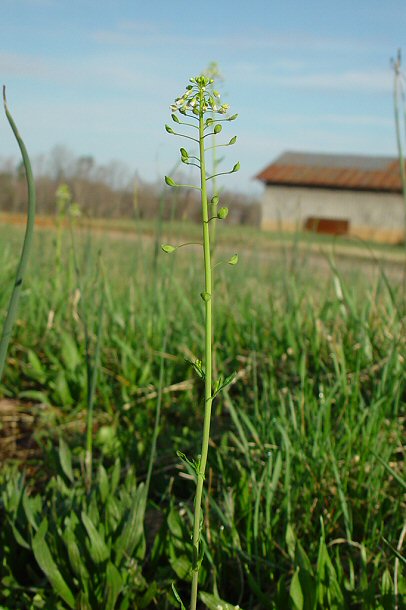Thlaspi alliaceum L.
Roadside Pennycress

Introduced
CC = *
CW = 5
MOC = 4
© DETenaglia
Thlaspi alliaceum L.Roadside Pennycress | |
 |
Introduced CC = * CW = 5 MOC = 4 |
© DETenaglia |
|
Family - Brassicaceae Habit - Taprooted annual forb, often glaucous, smelling strongly of garlic when bruised. Stems - Erect, to 60 cm, pubescent near the base, glabrous and glaucous above, sometimes multiple from the base.
Leaves - Alternate, sessile, auriculate, clasping, simple, 1-5 cm long, narrowly elliptic to oblong or ovate, toothed, glabrous. Auricles pointed. Basal leaves mostly absent at flowering time.
Inflorescence - Terminal and axillary racemes, compact in flower, greatly elongating in fruit. Pedicels to 5 mm long in flower, quickly elongating and spreading in fruit to 1.3 cm long, glabrous.
Flowers - Sepals 4, 1-2 mm long. Petals 4, 2.5-4.0 mm long. Styles 0.2-0.3 mm long. Stamens 6, erect. Filaments greenish, to 1.2 mm long, glabrous. Anthers yellow. Ovary superior, green, rotund, 1 mm in diameter, glabrous. Style short, thick, 0.2 mm long.
Fruits - Silicles 5-10 mm long, obovate, inflated, narrowly winged below, 2-valved, green, glabrous, with a shallow notch at the apex. Seeds mostly 3-5 per locule, 2-4 mm long, broadly ellipsoid, the surface with a netlike or honeycomb-like pattern of ridges and pits, dark brown to black.
Flowering - April - May. Habitat - Wet fields, roadsides, crop fields, disturbed flood plains. Origin - Native to Eurasia. Lookalikes - Thlaspi arvense. Other info. - This species is rare in Missouri, thus far reported from only four counties. The plant was first cataloged in North America in the early 1960s in North Carolina. Since then it has spread throughout parts of the eastern continental U.S., although it is apparently still widely scattered. At present Missouri represents the far western extent of the plant's spread. It is possible that some populations have been overlooked due to the plant's resemblance to the extremely common T. arvense. The latter species differs by having fruit which are strongly flattened and thin, rather than inflated. T. alliaceum also has long fruiting inflorescences a stronger allium odor when crushed. Fields with large populations of this plant present are redolent of garlic. Photographs taken at the Dr. Frederick Marshall Conservation Area, Platte County, MO., 5-6-01, and in Reidsville, NC., 3-23-03 (DETenaglia); also near Morse Mill Park, Jefferson County, MO, 4-20-2015, and at Columbia Bottoms Conservation Area, St. Charles County, MO, 4-24-2016 (SRTurner). |